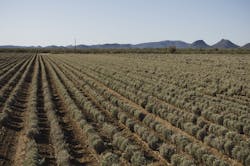Cooper Tire & Rubber Co. plans to produce a prototype tire in 2017 with 100% of its natural and synthetic rubber components substituted with those made from guayule, a shrub native to the U.S.
So instead of hevea natural rubber (HNR) tapped from rubber trees grown in countries such as India and Malaysia, components will be made from rubber extracted from a bush grown in Arizona and throughout the southwestern U.S.
This week the company demonstrated its third generation of test tires produced with several components made from 100% guayule. Cooper Tire held the industry's first ride-and-drive event using guayule tires.
Cooper Tire is leading the Biomass Research and Development Initiative (BRDI) project developing guayule (pronounced why-you-lee) as a substitute for HNR in tires. It is working with the United States Department of Agriculture-Agricultural Research Service (USDA-ARS), Cornell University, Arizona State University, Clemson University and PanAridus, a bio-agricultural company.
In 2012, Cooper and its consortium partners were awarded a four-year, $6.9 million grant to develop guayule manufacturing processes, test guayule as a strategic source of raw material in tires, and evaluate the remaining biomass for fuel applications. (See “Cooper gets grant for guayule plant.”)
Bridgestone Americas Tire Operations (BATO) also is studying the guayule plant. It opened its Agro Operations Guayule Research Farm in Eloy, Ariz., in October 2013 and a Biorubber Process Research Center in 2014 in Mesa, Ariz. (See “Bridgestone researches natural rubber sources,” “Bridgestone completes guayule research farm” and “Bridgestone begins producing natural rubber.”)
A passenger tire is composed of 41% rubber, 15% steel, 28% fillers and 16% fabric/other elements. The rubber itself is 30% to 35% natural rubber, 65% to 70% synthetic rubber.
Cooper reports the industry produced 26.6 billion pounds of HNR in 2014, and 70% of it was used by the tire industry. There is a limited growing area for the rubber trees, with 70% of production coming from Thailand, Indonesia and Malaysia. Rubber tree plantations are vulnerable to drought and disease, which can adversely affect production. Plus, historically, the price of rubber has fluctuated quite a bit.
The production of guayule will assure a stable rubber supply, reduce price volatility and create jobs when it is grown on U.S. soil. And when it is harvested in America, there will be improved logistics for domestic tire plants, Cooper notes.
Guayule will reduce global demand for HNR going forward. Cooper notes the demand for tires is expected to double in 30 years. An additional 21 million acres of land will be needed for HNR production to meet the increased global demand for tires by 2024. This raises questions on the impact of these crops on biodiversity and the ecosystems of the world.
Heading the guayule project at Cooper Tire are Chuck Yurkovich, senior vice president, global research and development, and Howard Colvin, senior research scientist, innovative technology, Global Technical Center. Cooper’s BRDI program’s objectives are to:
* Improve rubber and biomass yield of guayule
* Develop technology to product tire grade guayule
* Develop an innovative concept tire based on guayule
-- Compound development for each component (guayule is 10% rubber, 10% resin and 80% bagasse which can be used as a fuel source)
-- Processing on factory equipment
-- Comprehensive testing
* Develop guayule crop residues as an energy source
Researchers working with Cooper on the BRDI project are evaluating guayule cultivars to find the best one for the project, notes Colleen McMahan, Ph.D., lead scientist, domestic natural rubber, USDA-ARS, Western Regional Research Laboratory. Also being evaluated are methods for seeding, surface vs. sub-surface irrigation, fertilization, temperature and light.
In addition to the advances in rubber manufacturing and tire technology, consortium members USDA-ARS and Cornell also report significant progress in defining the guayule genome. Scientists may eventually be able to identify genes that can be tuned to improve qualities such as rubber yield, plant size, drought tolerance and other positive characteristics. (See more in “Cooper is testing tires made with guayule.”)
Cooper also is working with Mike Fraley, chief executive officer of PanAridus based in Casa Grande, Ariz., to develop the best guayule plant with the highest rubber content. “In two years we have gone from test tubes to tires,” says Fraley.
Expectations that need to be met for tires utilizing guayule are the same as tires with HNR – the ability to stop quickly, good fuel economy, good wear (in many cases a 50,000-mile warranty), all-season performance and safety. And the compounds must be able to be processed on all tire manufacturing equipment and be combined into a final composite which will perform as expected, says Colvin.
“All data so far through our multiple builds looks to be very good,” says Yurkovich. “Tires made with guayule components look to be equivalent to our products built with HNR. The company will do addition runs in the future.
“Beginning in 2017, the company plans to build a prototype tire replacing all the natural and synthetic rubber with guayule components. We will know then if we’re successful. However, even replacing 10% to 15% of the components with guayule will be a big success, due to the savings on the use of natural rubber. Say we use it in a tire production run of a million tires and we replace three pounds of natural rubber with guayule. That’s still a savings of three million pounds of rubber.”
The company’s goal is to have a tire with 100% guayule components cost the same as a tire with HNR and synthetic rubber components. “If we do this right, we should not see an increase in cost due to the guayule content. That would be the goal,” says Yurkovich. “The faster the industry changes, the better off we’ll be.”
A life cycle analysis to identify the environmental impact of a tire made with guayule and the extension into production of tires made with it is being conducted by Amy Landis, Clemson University professor, who is also part of the BRDI consortium.



